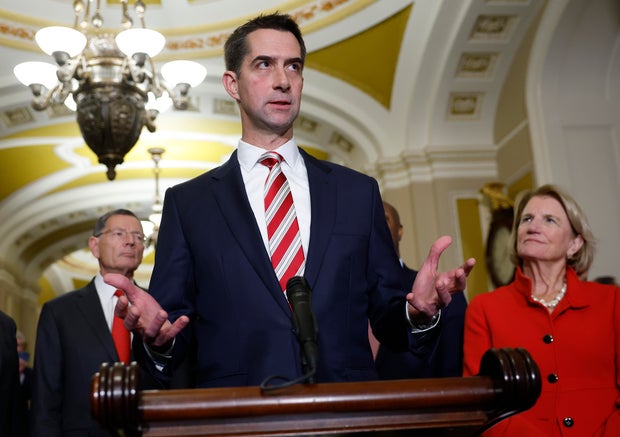Unauthorized drone flights over U.S. military installations, border facilities and mass public events are climbing to unprecedented levels, prompting warnings from top lawmakers that the country faces an escalating aerial security risk while it remains hamstrung by a patchwork of airspace protection capabilities.
Senate Intelligence Committee chairman Tom Cotton, a Republican from Arkansas, said in an interview with CBS News this week that the threat to military sites and large civilian gatherings “is severe and growing.” He cited evidence of persistent drone incursions and gaps in law enforcement authorities, many of which lapsed for weeks during the record-long government shutdown.
There were more than 350 unauthorized drone flights over about 100 military installations in 2024, according to the Defense Department, and government data shows there were more than 27,000 drones detected within 500 meters of the U.S. southern border in the last half of that year.
And while the number of stadium incursions waned slightly last year, the overall trend is continuing to move upward, according to NFL data, with drone incursions almost doubling, from 1,300 to 2,300, between 2021 and 2024.
Some of the incursions may be the fault of hobbyists or unwitting individuals, Cotton said, but inexpensive drone technologies have also proliferated across criminal organizations and non-state actors, raising the risks of mass-casualty attacks.
“It could be…unwittingly probing to see what the responses are – and responses have not been particularly strong, given these legal limitations,” he said of some drone overflights of sensitive U.S. military installations. Citing classification concerns, Cotton, who also sits on the Senate Armed Services Committee, declined to comment on how many overflights may have a connection to a foreign government, or which foreign governments may be involved.
U.S. security officials have previously issued public warnings that drone incursions near military bases, energy facilities and other critical infrastructure pose surveillance risks. Many of them may be traced to foreign-made or unidentified systems capable of collecting imagery or signals intelligence. The threat underscores legal holes in detection and authority as drone activity increasingly probes sensitive American airspace – potentially, some officials have warned, in preparation for kinetic attacks.
The coordinated drone strikes by Ukraine deep inside Russian territory on June 1 – known as Operation Spider’s Web — showed in dramatic fashion how relatively inexpensive unmanned systems can reach far-flung military targets. The operation reportedly deployed 117 drones to strike more than 40 Russian aircraft and caused approximately $7 billion in damage.
This example has been widely cited in U.S. security policy circles as a harbinger of how drone overflights or strikes might one day be carried out against U.S. or allied installations if defenses are not modernized, and authorities are not made more coherent.
Defense officials say many U.S. military bases, for example, aren’t authorized under current law to deploy defensive counter-drone systems. In February, at a hearing before the Senate Armed Services Committee, Gen. Gregory M. Guillot, commander of both U.S. Northern Command and North American Aerospace Defense Command, or NORAD, testified that only about half of U.S. military installations qualify as “covered” sites, which are authorized to intercept drones that pose security threats.
And while a handful of federal entities — including the Departments of Defense, Homeland Security, Energy and Justice — are currently authorized to detect, track, or disable drones, state and local agencies remain largely powerless even when drones threaten civilian sites, including airports or stadiums.
Cotton pointed to the rise in drone activity over major sporting venues as evidence of the broader vulnerability of civilian targets, with heightened risks expected around the Olympics and World Cup – both set to be hosted by the U.S. next year.
A sports industry security official confirmed in a phone interview with CBS News that the threat to civilian targets at mass gatherings from drone overflights is “real and it’s increasing.”
“The vast majority are the clueless or the careless,” the official said, referring to drone operators who ignore or misunderstand temporary flight restrictions over stadiums and arenas. “But there are also cases where the drone operator has acted very aggressively and evaded detection,” the official said, estimating there are about “a dozen” such cases each year.
“Thankfully, just by luck, we haven’t had something bad happen — whether an accident where somebody crashes their drone into fans, or whether they weaponize a drone and drop something dangerous into a stadium,” said the official, speaking on condition of anonymity to discuss sensitive security considerations.
While no mass-casualty or payload-delivery plot targeting a U.S. sporting event has ever been publicly confirmed, security officials say that the volume and frequency of incursions make it more plausible.
Cotton, along with bipartisan co-sponsors, is backing two measures aimed at closing enforcement gaps. The first, co-sponsored by Democratic Senator Jacky Rosen of Nevada, is the DEFENSE Act, which would allow trained state and local law enforcement officers to detect, track and disable hostile drones at large public gatherings. The second measure, the COUNTER Act, is co-sponsored by New York Democratic senator Kirsten Gillibrand and expands the definition of a covered site to allow more American bases to track and neutralize drones.
If Congress does not act urgently to match its laws to the evolving threat, Cotton warned, the U.S. may find it’s reacting after a catastrophic event, rather than being prepared before one occurs. And while the federal government is now funded through January 30, the next major funding showdown is already looming.
That means critical airspace protection authorities “remain in place until the end of January – a week before the Super Bowl is going to be played,” Cotton said. “I think we should try to make those authorities permanent, not just so it’s not hostage to government funding anymore, but so DHS, working with other federal agencies, can be more certain in what it can plan for and train for.”

